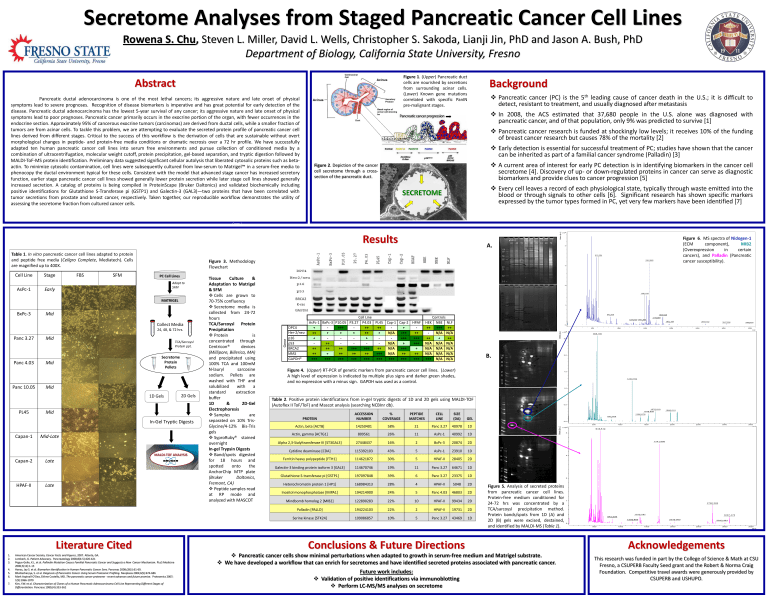Abstract Rowena S. Chu, Department of Biology, California State University, Fresno

Secretome Analyses from Staged Pancreatic Cancer Cell Lines
Rowena S. Chu, Steven L. Miller, David L. Wells, Christopher S. Sakoda, Lianji Jin, PhD and Jason A. Bush, PhD
Department of Biology, California State University, Fresno
Figure 1
. (
Upper
) Pancreatic duct cells are nourished by secretions from surrounding acinar cells.
( A)
Lower
) Known gene mutations correlated with specific PanIN pre-malignant stages.
Abstract
Pancreatic ductal adenocarcinoma is one of the most lethal cancers; its aggressive nature and late onset of physical symptoms lead to severe prognoses. Recognition of disease biomarkers is imperative and has great potential for early detection of the disease. Pancreatic ductal adenocarcinoma has the lowest 5-year survival of any cancer; its aggressive nature and late onset of physical symptoms lead to poor prognoses. Pancreatic cancer primarily occurs in the exocrine portion of the organ, with fewer occurrences in the endocrine section. Approximately 95% of cancerous exocrine tumors (carcinomas) are derived from ductal cells, while a smaller fraction of tumors are from acinar cells. To tackle this problem, we are attempting to evaluate the secreted protein profile of pancreatic cancer cell lines derived from different stages. Critical to the success of this workflow is the derivation of cells that are sustainable without overt morphological changes in peptide- and protein-free media conditions or dramatic necrosis over a 72 hr profile. We have successfully adapted ten human pancreatic cancer cell lines into serum free environments and pursue collection of conditioned media by a combination of ultracentrifugation, molecular weight cutoff, protein precipitation, gel-based separation, and tryptic digestion followed by
MALDI-ToF-MS protein identification. Preliminary data suggested significant cellular autolysis that liberated cytosolic proteins such as betaactin. To minimize cytosolic contamination, cell lines were subsequently cultured from low-serum to Matrigel™ in a serum-free media to phenocopy the ductal environment typical for these cells. Consistent with the model that advanced stage cancer has increased secretory function, earlier stage pancreatic cancer cell lines showed generally lower protein secretion while later stage cell lines showed generally increased secretion. A catalog of proteins is being compiled in ProteinScape (Bruker Daltonics) and validated biochemically including positive identifications for Glutathione S-Transferase pi (GSTP1) and Galectin-3 (GAL3)—two proteins that have been correlated with tumor secretions from prostate and breast cancer, respectively. Taken together, our reproducible workflow demonstrates the utility of assessing the secretome fraction from cultured cancer cells.
Figure 2
. Depiction of the cancer cell secretome through a crosssection of the pancreatic duct.
SECRETOME
Background
Pancreatic cancer (PC) is the 5 th leading cause of cancer death in the U.S.; it is difficult to detect, resistant to treatment, and usually diagnosed after metastasis
In 2008, the ACS estimated that 37,680 people in the U.S. alone was diagnosed with pancreatic cancer, and of that population, only 9% was predicted to survive [1]
Pancreatic cancer research is funded at shockingly low levels; it receives 10% of the funding of breast cancer research but causes 78% of the mortality [2]
Early detection is essential for successful treatment of PC; studies have shown that the cancer can be inherited as part of a familial cancer syndrome (Palladin) [3]
A current area of interest for early PC detection is in identifying biomarkers in the cancer cell secretome [4]. Discovery of up- or down-regulated proteins in cancer can serve as diagnostic biomarkers and provide clues to cancer progression [5]
Every cell leaves a record of each physiological state, typically through waste emitted into the blood or through signals to other cells [6]. Significant research has shown specific markers expressed by the tumor types formed in PC, yet very few markers have been identified [7]
Table 1
.
In vitro
pancreatic cancer cell lines adapted to protein and peptide free media (
Cellgro Complete
, Mediatech). Cells are magnified up to 400X.
Cell Line Stage FBS SFM
AsPc-1 Early
BxPc-3
Panc 3.27
Mid
Panc 4.03
Mid
PL45
Capan-2 Late
HPAF-II
Mid
Panc 10.05
Mid
Mid
Capan-1 Mid-Late
Late
Literature Cited
PC Cell Lines
Adapt to
SFM
MATRIGEL
Collect Media
24, 48, & 72 hrs.
TCA/Sarcoysl
Protein ppt.
Secretome
Protein
Pellets
1D Gels
1.
American Cancer Society. Cancer Facts and Figures , 2007. Atlanta, GA.
2.
Lomberk, G. Patient Advocacy . Pancreatology 2008;8(4-5):420-421
3.
Pogue-Geile, K.L. et al. Pallindin Mutation Causes Familial Pancreatic Cancer and Suggests a New Cancer Mechanism . PLoS Medicine
2006;3(12):1-13
4.
Hanas, Jay S. et al. Biomarker Identification in Human Pancreatic Cancer Sera . Pancreas 2008;(36)1:61-69.
5.
Bhattacharyya, S. et al. Diagnosis of Pancreatic Cancer Using Serum Proteomic Profiling.
Neoplasia 2004;6(5):674-686
6.
Mark Aspinall-O'Dea, Eithne Costello, MD. The pancreatic cancer proteome - recent advances and future promise.
Proteomics 2007;
1(9):1066-1079
7.
Kim, Y.W. et al. Characterization of Clones of a Human Pancreatic Adenocarcinoma Cell Line Representing Different Stages of
Differentiation. Pancreas 1989;(4):353-362
2D Gels
In-Gel Tryptic Digests
MALDI-TOF ANALYSIS
Capan-1 x10
4
Results
A.
Figure 3.
Methodology
Flowchart
Tissue Culture &
Adaptation to Matrigel
& SFM
Cells are grown to
70-75% confluency
Secretome media is collected from 24-72 hours
TCA/Sarcoysl Protein
Precipitation
Protein is concentrated through
Centricon® devices
(Millipore, Billerica, MA)
and precipitated using
100% TCA and 100mM
N-lauryl sarcosine sodium.
Pellets are washed with THF and solubilized with a standard buffer extraction
1D &
Electrophoresis
Samples
2D-Gel
are separated on 10% Tris-
Glycine/4-12% Bis-Tris gels
SyproRuby® stained overnight
In-gel Trypsin Digests
Band/spots digested for 18 hours and spotted onto the
AnchorChip MTP plate
(Bruker Daltonics,
Fremont, CA)
Peptide samples read at RP mode and analyzed with MASCOT
BRCA2
K-ras
DPC4 +
Her-2/ neu ++ p16 p53
+
-
BRCA2 kRAS
GAPDH*
Cell Line Controls
AsPc-1 BxPc-3 P10.05 P3.27 P4.03
PL45 Cap-1 Cap-2 HPAF HEK NBE NLF
-
+
-
++
+++
+
-
-
-
+
-
-
++
++
+
-
++
+ N/A +++ ++
-
-
-
-
N/A
+
+++
+
-
+++
+++
++
-
++
N/A
+++ ++
N/A N/A
+ ++
N/A N/A
++
++
++
+
++
++
+++
++
+++
++
++
+++
N/A
N/A
+++
++
+
++
N/A
N/A
N/A N/A
N/A N/A
+++ +++ +++ +++ +++ +++ +++ +++ +++ +++ N/A N/A
BxPc-3
Figure 4.
(
Upper
) RT-PCR of genetic markers from pancreatic cancer cell lines. (
Lower
)
A high level of expression is indicated by multiple plus signs and darker green shades, and no expression with a minus sign. GAPDH was used as a control.
B.
HPAF-I I
P4.03
0 x10
4
2.5
Table 2
. Positive protein identifications from in-gel tryptic digests of 1D and 2D gels using MALDI-TOF
(Autoflex II ToF/ToF) and Mascot analysis (searching NCBInr db).
PROTEIN
Actin, beta [ACTB]
Actin, gamma [ACTG1]
ACCESSION
NUMBER
14250401
809561
%
COVERAGE
58%
26%
PEPTIDE
MATCHES
21
11
CELL
LINE
SIZE
(DA) GEL
Panc 3.27
40978 1D
AsPc-1 40992 1D
Alpha 2,3-Sialyltransferase III [ST3GAL3]
Cytidine deaminase [CDA]
Ferritin heavy polypeptide [FTH1]
Galectin-3 binding protein isoform 3 [GAL3]
Glutathione S-transferase pi [GSTP1]
Heterochromatin protein 1 [HP1]
Inositol monophosphatase [IMPA1]
Mindbomb homolog 2 [MIB2]
Palladin [PALLD]
Serine kinase [STK24]
27448437
115392103
114621872
114670746
197097848
168984313
194214900
122890283
194224103
109086857
16%
43%
30%
19%
39%
28%
24%
22%
22%
10%
10
2
5
11
6
4
5
2
5
5
BxPc-3 20874 2D
AsPc-1 23910 1D
HPAF-II 28405 2D
Panc 3.27
64671 1D
Panc 3.27
23375 1D
HPAF-II 5048 2D
Panc 4.03
46803 2D
HPAF-II 99434 2D
HPAF-II 19731 2D
Panc 3.27
43469 1D
Conclusions & Future Directions
Pancreatic cancer cells show minimal perturbations when adapted to growth in serum-free medium and Matrigel substrate.
We have developed a workflow that can enrich for secretomes and have identified secreted proteins associated with pancreatic cancer.
Future work includes:
Validation of positive identifications via immunoblotting
Perform LC-MS/MS analyses on secretome
0.5
0.0
x10
4
4
Figure 5.
Analysis of secreted proteins from pancreatic cancer cell lines.
Protein-free medium conditioned for
24-72 hrs was concentrated by a
TCA/sarcoysl precipitation method.
Protein bands/spots from 1D (A) and
2D (B) gels were excised, destained, and identified by MALDI-MS (
Table 1
).
1
0
2
3
3
2
1
2.0
1.5
1.0
4
615.354
500
568.156
842.509
1000
1275.725 1441.695
1500
1839.028
1716.864
1971.122
2000
1230.784
1581.865
1491.810
500
615.412
842.509
1000
1676.918
1548.809
1386.878
1966.010
1500 2000
1741.956
Figure 6
. MS spectra of Nidogen-1
(ECM component), MIB2
(Overexpression in certain cancers), and
Palladin
(Pancreatic cancer susceptibility).
2500
2647.152
3047.598
3000
3489.454
3500 m /z
2500 3000 3500 m /z
2760.269
500
842.509
1000
1372.787
1229.883
1500
2039.990
2000 2500
3087.478
2943.464
3000 3500 m /z



